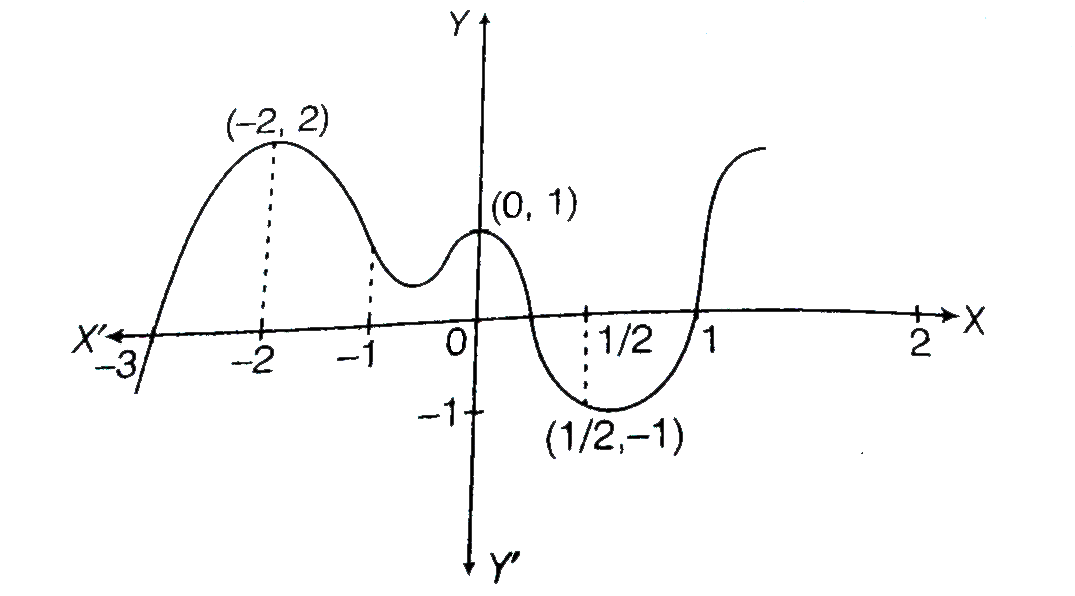If the function f(x)=x3−9x2+24x+c has three real and distinct roots α,βandγ, then the value of [α]+[β]+[γ] is
5, 6 ,7
6, 7 ,8
7, 8 ,9
None of these
To solve the problem, we need to find the value of (α)+(β)+(γ) where α, β, and γ are the roots of the polynomial function f(x)=x3−9x2+24x+c. The roots must be real and distinct.
1. Identify the polynomial: We are given the polynomial function:
f(x)=x3−9x2+24x+c
2. Use Vieta's formulas: According to Vieta's formulas, for a cubic polynomial ax3+bx2+cx+d=0, the sum of the roots α+β+γ is given by:
α+β+γ=−ba
Here, a=1 and b=−9. Therefore:
α+β+γ=9
3. Consider the fractional parts: We need to find (α)+(β)+(γ). Let:
α=n1+f1,β=n2+f2,γ=n3+f3
where ni are the integer parts and fi are the fractional parts such that 0≤fi<1.
4. Express the sum: The sum of the roots can be expressed as:
α+β+γ=(n1+n2+n3)+(f1+f2+f3)=9
5. Analyze the fractional part: Since 0≤f1+f2+f3<3, we can conclude:
n1+n2+n3=9−(f1+f2+f3)
This implies:
n1+n2+n3=9−k
where k=f1+f2+f3 and 0≤k<3.
6. Determine possible integer values: The possible values for n1+n2+n3 can be:
- If k=0, then n1+n2+n3=9
- If k=1, then n1+n2+n3=8
- If k=2, then n1+n2+n3=7
7. Conclusion: Thus, the possible values for (α)+(β)+(γ) are:
- 7 (if k is close to 2)
- 8 (if k is close to 1)
- 9 (if k is 0)
Therefore, the possible values of (α)+(β)+(γ) are 7,8,9.
8. Final Answer: The correct answer is:
The value of (α)+(β)+(γ) is 7,8,9.
f(x)=x3−9x2+24x+c
α+β+γ=−ba
Here, a=1 and b=−9. Therefore:
α+β+γ=9
α=n1+f1,β=n2+f2,γ=n3+f3
where ni are the integer parts and fi are the fractional parts such that 0≤fi<1.
α+β+γ=(n1+n2+n3)+(f1+f2+f3)=9
n1+n2+n3=9−(f1+f2+f3)
This implies:
n1+n2+n3=9−k
where k=f1+f2+f3 and 0≤k<3.
- If k=0, then n1+n2+n3=9
- If k=1, then n1+n2+n3=8
- If k=2, then n1+n2+n3=7
- 7 (if k is close to 2)
- 8 (if k is close to 1)
- 9 (if k is 0)
The value of (α)+(β)+(γ) is 7,8,9.
Topper's Solved these Questions
- DY / DX AS A RATE MEASURER AND TANGENTS, NORMALS BOOK - ARIHANT MATHS ENGLISHCHAPTER - DY / DX AS A RATE MEASURER AND TANGENTS, NORMALS EXERCISE - SINGLE OPTION CORRECT TYPE QUESTIONS
9 Videos
- DY / DX AS A RATE MEASURER AND TANGENTS, NORMALS BOOK - ARIHANT MATHS ENGLISHCHAPTER - DY / DX AS A RATE MEASURER AND TANGENTS, NORMALS EXERCISE - Exercise For Session 1
15 Videos
- DY / DX AS A RATE MEASURER AND TANGENTS, NORMALS BOOK - ARIHANT MATHS ENGLISHCHAPTER - DY / DX AS A RATE MEASURER AND TANGENTS, NORMALS EXERCISE - Exercise (Questions Asked In Previous 13 Years Exam)
7 Videos
- DIFFERENTIATION BOOK - ARIHANT MATHS ENGLISHCHAPTER - DIFFERENTIATION EXERCISE - Exercise For Session 10
4 Videos
- ELLIPSEBOOK - ARIHANT MATHS ENGLISHCHAPTER - ELLIPSEEXERCISE - Exercise (Questions Asked In Previous 13 Years Exam)
27 Videos
Similar Questions
Let f(x)=x3−9x2+24x+c=0 have three real and distinct roots α,β and λ.
(i) Find the possible values of c.
(ii) If [α]+[β]+[λ]=8, then find the values of c, where [⋅] represents the greatest integer function.
(ii) If [α]+[β]+[λ]=7, then find the values of c, where [⋅] represents the greatest integer function.s
View SolutionIf p''(x) has real roots α,β,γ. Then , [α]+[β]+[γ] is

View SolutionLet f(x)=xcosx,x∈[3π2,2π]andg(x) be its inverse. If ∫2π0g(x)dx=aπ2+βπ+γ, where α,βandγ∈R, then find the value of 2(α+β+γ).
View SolutionIf roots of x3+2x2+1=0 are α,βandγ, then the vlaue of (αβ)3+(βγ)3+(αγ)3, is :
View SolutionIf α,β,γ are the roots of x3+x2−5x−1=0 then α+β+γ is equal to
View SolutionLet α,βandγ are the roots of the equation 2x2+9x2−27x−54=0. If α,β,γ are in geometric progression, then the value of |α|+|β|+|γ|=
View SolutionIf α,βandγ are the roots of the equation x3−13x2+15x+189=0 and one root exceeds the other by 2, then the value of |α|+|β|+|γ| is equal to
View SolutionIf 2x3+3x2+5x+6=0 has roots α,β,γ then find α+β+γ,αβ+βγ+γα and αβγ
View SolutionIf α,β,γ are the roots of the equation x3+px2+qx+r=0 then the coefficient of x in cubic equation whose roots are
α(β+γ),β(γ+α)andγ(α+β) is
View SolutionIf α,β,γ are the roots of the equation x3+2x2−x+1=0, then vlaue of (2−α)(2−β)(2−γ)(2+α)(2+β)(2+γ) is :
View Solution
